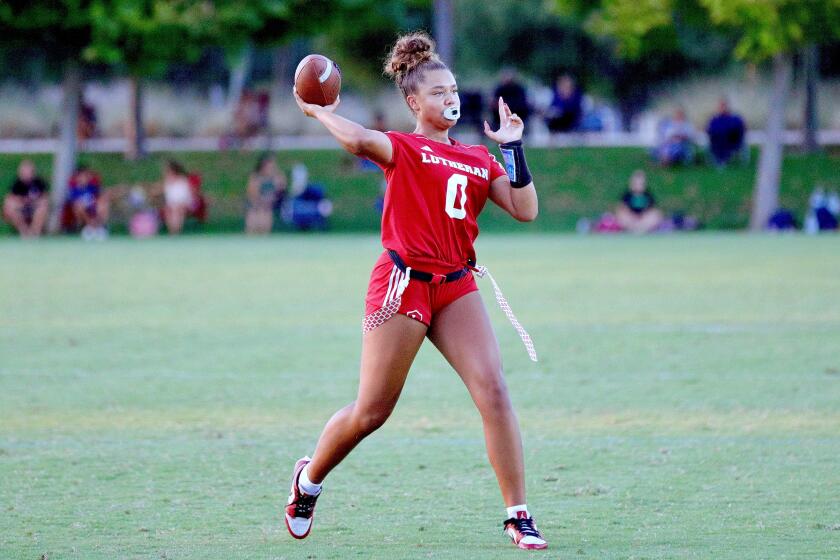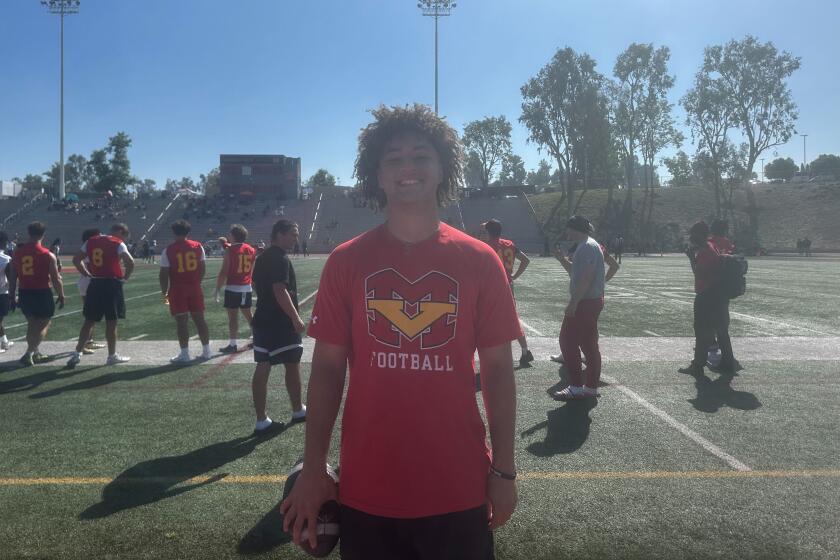Unanswered Calls
- Share via
Darrel Havens has lost track of the times he has journeyed from Lancaster into northern Inyo County and beyond to referee high school sports during the last 30 years.
Enough, he says, that he probably could make the drive with his eyes closed. And although those round trips of eight hours and 400 miles seem like a long way to go for a $45 referee fee and about $40 in mileage, Havens knows exactly what would happen if he didn’t do it.
“They would have to cancel the games,” he said.
That’s because of a nationwide shortage of high school sports officials. Referee and umpire associations throughout the country have reported a need for help. Games, especially at levels below varsity, are routinely understaffed, regularly rescheduled and sometimes canceled because of the lack of qualified officials.
In a day of two-income households, it has become more and more difficult to recruit competent people away from their day jobs for 3:15 p.m. games to earn a meager stipend.
Add the ever-increasing number of violent outbursts against game officials and the task of recruiting becomes even more difficult.
“It’s a problem we’re all concerned about, and as we move forward it doesn’t seem to be getting better,” said Rob Wigod, a Southern Section assistant commissioner. “It’s like, ‘Where are we going to be in five years?’
“If it stays at the same number of officials, we’re going to have serious problems.”
The problem is not yet critical in Southern California, where varsity games almost always go off as scheduled with a sufficiently staffed crew, but the shortage is enough to leave assigners scrambling to get games covered on a daily basis.
Sometimes that means sending Havens on a 200-mile drive up Highway 395 for a two-hour volleyball game only to turn around for the four-hour trip home -- something he did on eight consecutive Tuesdays last fall to referee matches at Lone Pine, Big Pine and Mammoth highs.
“I don’t think it’s getting any better,” Havens said. “You do it because you love it and for the kids, but pretty soon there are going to be cases where games are canceled because we simply will not have enough referees.”
A 2001 survey by the National Assn. of Sports Officials showed that 80% of states were experiencing a shortage at the high school level. The key reasons were an increase in the number of contests -- spurred by the addition of high schools and new sports -- and the inability to recruit and retain people for the job.
Mike Kearns, a basketball assigner in the eastern San Gabriel Valley, said without new, young referees and officials, the current batch eventually will become too old to continue and there won’t be one to take its place.
As it is, he said, the mean age of officials in his area is about 60.
“Five or 10 years from now, this problem is going to be atrocious,” said Kearns, 58, who umpires softball and is a football referee in addition to his basketball duties. “We’re all old at the same time. I see very few officials in their 30s these days. Fifteen years ago there were 20 or 30.”
Getting recruits into striped shirts and getting them to stay are related problems. The increase in media scrutiny over officials’ calls, advances in instant replay technology and television highlight shows are to blame, according to some.
“You turn on ESPN and all they do is talk about how the umpires and referees got it wrong,” said Terry Calhoun, a baseball umpire in the City Section. “Then they show 50 different angles, and the 50th one shows how that umpire missed a call he needed to make in one-tenth of a second. Or they show highlights of some guy kicking dirt all over an umpire. Who’s going to want to be an umpire after they see those things?”
And several Southern California assigners say that recruiting officials is easier than keeping them.
Poor sportsmanship is far and away the biggest reason for that. At a girls’ water polo game between San Gorgonio and San Bernardino in January, for instance, a fan rushed from the stands and allegedly punched referee Nic Simental in the face.
Referees and umpires realize that it’s part of the job to deal with occasional outbursts, but violence is becoming more common. According to documents obtained by The Times, there were 1,104 reports filed with the Southern Section detailing incidents that warranted player, coach or fan ejections during the 2005-06 fall and winter sports seasons.
“We get more reports of assaults on officials than we ever have in history,” said Barry Mano, president of the National Assn. of Sports Officials. “It’s a developing problem at the high school level, but the potential for mayhem is great.... I think acting out has become more acceptable.”
Rivalries and big games often spark intensity, but Bill Gayler, president of the California Basketball Officials Assn., identified one key reason for the rise in poor sportsmanship directed at officials: college scholarships.
“High school sports has become big business,” Gayler said. “If scouts are there watching and you blow a whistle and the kid has to sit, then you’re the bad guy. People just don’t want to deal with that kind of [nonsense] for the pay we get.”
The pay scale for referees and umpires ranges from about $45 to $65 per game, depending on the sport. A baseball umpire can work five or six games a week and make almost $400, but the proliferation of recreational sports opportunities has also hurt at the high school level.
A Pop Warner football referee, for example, could officiate four games on a Saturday afternoon and earn close to $150 in a relatively low-pressure environment. Coed softball umpires can earn $50 for a 75-minute game during which they won’t have to deal with unruly fans.
“You can’t match that at the high school level,” said Ken Wilson, who oversees high school officials in the South Bay area. “It’s a lot more relaxed and easier to do and you can make decent money. People would simply rather do that.”
As the pool of officials shrinks, the demand for them grows. The City Section is opening five high schools next year and 20 by 2012. Southern Section membership has increased from 487 to 561 schools over the last decade and has five more scheduled to join next year.
Some schools and leagues are altering schedules to accommodate the need. That sometimes means giving up the prime Friday night time slots for contests -- and the increased gate revenue they bring -- and instead playing on Tuesdays or Thursdays.
For example, when the Southern Section baseball playoffs begin next week, first-round games for the first time will be split between Thursday and Friday.
Some games are officiated short-handed: one umpire instead of two for baseball or softball, two referees instead of three for basketball and soccer.
“We work an awful lot of one referee in soccer,” said Lloyd Nixon, who oversees referees in the Inland Empire area. “But when you go short-handed, you’re only hurting the kids. An official can only see so much.”
Another way to combat the problem is to have boy-girl doubleheaders in basketball with the same crew working both games or to have freshman-sophomore, junior varsity and varsity contests scheduled in succession with the same crew working all three games.
The problem is that by the end of the night, officials aren’t as fresh for the more important varsity game.
“It impacts your ability to get into position to make the right call,” Nixon said. “You’re the most tired for the game that moves the fastest. It’s not right.”
The desperate need for officials sometimes leads to what Al Walters calls “warm-body officiating.” The theory is that anyone with a warm body can do the job, said Walters, a baseball assigner for the City Section.
Walters said he is strict about using umpires who have passed certification tests, but he knows of other units that use uncertified umpires.
“We had a couple of guys that did not pass, so I didn’t give them any games,” he said. “The next thing you know, they are working games in other units. But that’s what the situation is now. It’s almost to the point where you take anyone who is willing to do it.”
And these days, anyone who is willing to drive to the games. City Section officials are not reimbursed for mileage. The Southern Section pays a small stipend on an escalating scale for round trips covering more than 50 miles. But it’s not nearly enough to cover wear and tear on automobiles and, with skyrocketing gas prices, some officials are turning down assignments that require significant travel.
Even Havens, who has been making trips to Mammoth, Bishop and Lone Pine for 30 years, said he was beginning to think it might no longer be worth it.
“You end up paying more to get there and in wear and tear than you earn for officiating the game,” he said. “And that doesn’t factor in the time sacrifice you have to make. You’re away from your family. If you want to be involved, you have to do those things, but more and more we’re seeing that guys aren’t willing to make those sacrifices.”
*
Times staff writer Lauren Peterson contributed to this report.
More to Read
Get our high school sports newsletter
Prep Rally is devoted to the SoCal high school sports experience, bringing you scores, stories and a behind-the-scenes look at what makes prep sports so popular.
You may occasionally receive promotional content from the Los Angeles Times.






